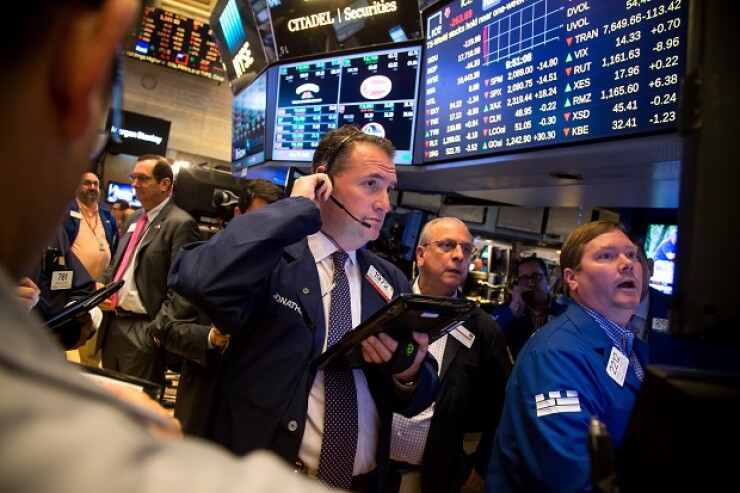
(Bloomberg) -- Timothy Pettee is beating all of his stock picking rivals without spending a lot of time picking stocks.
Pettee, who runs the $11.5 billion SunAmerica Focused Dividend Strategy Portfolio, selects 30 stocks only once a year using a quantitative model that does the heavy lifting. The mutual fund has returned 9.7% a year on average over the past decade, the best performance among more than 260 U.S. large-cap value funds, according to data compiled by Bloomberg.
At a time when stock pickers are losing prestige and assets, Pettee has been gathering both by beating his peers in seven of the last 10 years. His model chooses companies based on cheap prices, profitability and a high dividend yield -- a critical driver of performance in today's low interest-rate world. To make the cut, a stock must have a higher yield than the median of the S&P 500 Index.
"Yield is the 800-pound gorilla," Pettee, 58, said in an interview. "The quest for quality yield is the most powerful force in investing today and it is pushing people towards dividend-paying equities."
TOP DIVIDEND FUNDS
SunAmerica is the best performing dividend-focused large-cap value fund over 10 years.
Pettee's model usually selects its 30 stocks at the end of October and they stay in the fund for a year, except in unusual circumstances such as takeovers and dividend cuts. In a typical year about a third of the stocks change.
The manager sees the self-imposed restrictions on tweaking the portfolio as a plus.
"The fact that we are not constantly reacting to the news is one of the reasons for our success," Pettee said. "We are not out there making mistakes."
ASSETS GROWING
The SunAmerica fund, which is co-managed by Andrew Sheridan and Tim Campion in Jersey City, New Jersey, has seen its assets rise almost ten-fold since 2011 while most active managers have struggled to retain investors. Active mutual and exchange-traded funds had redemptions of $308 billion in the year ended May 31, according to Morningstar.
In the first five months of 2016, only 39% of active U.S. mutual funds beat their benchmark, Morningstar data show. The figure drops to 30% over five years.
Pettee, the chief investment strategist at SunAmerica Asset Management, is hardly the only manager benefiting from the boom in higher yielding equities. Over the past year, the two top-performing large-cap value funds were the $13.9 billion Federated Strategic Value Dividend Fund, up 17%, and the $1.8 billion Invesco Dividend Income Fund, with a 13% gain.
The dividend strategy could lose its luster if interest rates rise sharply, luring investors into bonds, said Michael Mullaney, chief investment officer at Fiduciary Trust, where he helps manage $11.5 billion. A rate hike this year became less likely after the U.K. vote to leave the European Union sent global markets into a tailspin.
"I don't see that happening any time soon," Mullaney said about a rate increase.
BAD CONSUMER BETS
Pettee's model has made missteps. The fund trailed 84% of peers in 2014 as two consumer holdings, toy maker Mattel and handbag producer Coach, both fell more than 30%.
The SunAmerica fund model was developed by Brendan Voege, a former analyst at the firm. Pettee oversaw its development and implementation and has run the fund since 2013.
The fund draws stocks from two pools. The ten highest-yielding securities from the Dow Jones Industrial Average automatically go into the portfolio. This year, two of them -- Verizon Communications and Exxon Mobil -- are up at least 20%, contributing to the fund's 7% gain, better than 93% of peers. The other 20 securities come from the Russell 1000 Index, a common benchmark for large-cap stocks, based on a blend of the three factors.
In its best year, 2009, the fund returned 48% compared with 26% for the S&P 500 Index. Bets on value stocks -- industrials in 2009, health care in 2010 and consumer discretionary in 2012 -- paid off in the following years, said Kevin McDevitt, a Morningstar analyst.
"You can't help but respect the results they have achieved," said McDevitt. "But because it all comes from a model, it is hard to completely explain it."






